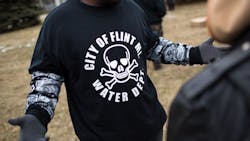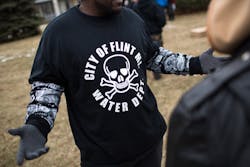Recently, I wrote about Legionnaire’s disease as a trend for 2016. Little did I expect it would become breaking news almost the very next day, when drinking-water contamination in Flint, Mich., began making headlines. Although state and federal officials maintain there is no clear evidence of a direct connection between Flint’s (not so) potable-water supply and an outbreak of Legionnaire’s disease, 87 cases, 10 of them fatal, in 17 months, compared with six to 13 cases in the four years prior to the water supply becoming compromised, is disturbing. According to Eden Wells, chief medical executive for Michigan’s Health and Human Services Department: "Eighty-seven cases is a lot. That tells us that there is a source there that needs to be investigated."
ANSI/ASHRAE Standard 188-2015, Legionellosis: Risk Management for Building Water Systems, represents our industry’s best attempt to establish risk-management requirements for building water systems. Historically, most cases of Legionnaire’s disease have occurred when water mist contaminated with Legionnaires' disease bacteria (LDB) has been inhaled. Cooling towers have been recognized, along to a lesser degree with hot tubs and whirlpool spas, showers, and water features (such as decorative fountains), as the primary culprits in most of the reported cases. However, Dr. Joseph Cotruvo, a former official with the U.S. Environmental Protection Agency’s (EPA’s) Office of Water, reported Centers for Disease Control and Prevention data from 2009-2010 show 19 of 33 outbreaks of waterborne disease—resulting in 105 cases of Legionnaire’s disease and 14 fatalities—were associated with LDB in potable-water distribution and plumbing systems. Although U.S. drinking water is among the safest in the world, there clearly is some risk, particularly if adequate central and local water-treatment protocols are not followed, as seems to be the case in Flint.
For readers unfamiliar with the drinking-water issues there, Flint is an economically depressed city of about 100,000 people located on the Flint River, approximately 66 miles northwest of Detroit, in Genesee County. Until two years ago, Genesee County bought its water from Detroit, which took it from Lake Huron. To save a reported $19 million per year, the state made the decision to have the county obtain its water from the Flint River. Shortly after the change, residents started complaining about the appearance, odor, and taste of the water. Although testing revealed the water contained high levels of lead and iron, it was months before either the state or the EPA admitted the problem and took action. In fact, an EPA water expert began investigating the water contamination in February 2015, confirmed his suspicions in April 2015, and wrote a memo to the local ranking EPA official, who, instead of acting immediately, quietly fought with the Michigan Department of Environmental Quality for at least six months about what should be done.
It wasn’t until Jan. 5 of this year that a state of emergency for Genesee County was declared, and now National Guard troops are providing bottled water to residents. As a proud Hokie, I’m pleased to report it was a Virginia Tech researcher—Dr. Marc Edwards—who used the Freedom of Information Act to obtain the documents that exposed the cover-up. Now, the political and legal fallout has begun, with calls for the mayor’s removal from office, threats of a class-action suit by residents, and the resignation of at least one senior EPA official. I wonder how many of the individuals who made those bad decisions were professional engineers, licensed plumbers, or water-treatment specialists? The involvement of such professionals might have made a difference.
About the Author
Larry Clark
A member of HPAC Engineering’s Editorial Advisory Board, Lawrence (Larry) Clark, QCxP, GGP, LEED AP+, is principal of Sustainable Performance Solutions LLC, a South Florida-based engineering firm focused on energy and sustainability consulting. He has more than two dozen published articles on HVAC- and energy-related topics to his credit and frequently lectures on green-building best practices, central-energy-plant optimization, and demand-controlled ventilation.

